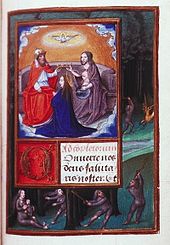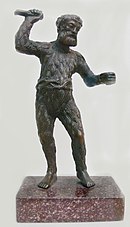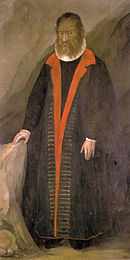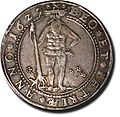Wild man

Thewild man,wild man of the woods,orwoodwose/wodewoseis a mythical figure and motif that appears in the art and literature ofmedieval Europe,comparable to thesatyrorfauntype inclassical mythologyand toSilvanus,the Roman god of thewoodlands.
The defining characteristic of the figure is its "wildness"; from the 12th century, it was consistently depicted as being covered with hair. Images of wild men appear in the carved and paintedroof bosseswhere intersectingogeevaultsmeet inCanterbury Cathedral,in positions where one is also likely to encounter the vegetalGreen Man.The image of the wild man survived to appear as supporter forheraldiccoats-of-arms,especially in Germany, well into the 16th century.Renaissanceengravers in Germany and Italy were particularly fond of wild men, wild women, and wild families, with examples fromMartin Schongauer(died 1491) andAlbrecht Dürer(1471–1528) among others.
Terminology
[edit]
The normalMiddle Englishterm, also used to the present day, waswoodwoseorwodewose(also spelledwoodehouse,wudwasetc., understood perhaps as variously singular or plural).[1][2]Wodwos[3]occurs inSir Gawain and the Green Knight(c. 1390).[4]The Middle English word is first attested for the 1340s, in references to the wild man popular at the time in decorative art, as in a Latin description of antapestryof theGreat WardrobeofEdward III,[5]but as a surname it is found as early as 1251, of oneRobert de Wudewuse.In reference to an actual legendary or mythological creature, the term is found during the 1380s, inWycliffe's Bible,translatingשעיר(LXXδαιμόνια,Latinpilosimeaning "hairy" ) inIsaiah13:21[6]The occurrences inSir Gawain and the Green Knightdate to soon after Wycliffe's Bible, to c. 1390.[7]
TheOld Englishform ofwoodwoseis unattested, but it would have been either*wudu-wāsaor*wude-wāsa.The first element is usually explained as fromwudu"wood, forest".[2]The second element is less clear. It has been identified as a hypothetical noun*wāsa"being", from the verbwesan,wosan"to be, to be alive".[8]It might alternatively mean a forlorn or abandoned person, cognate with GermanWaiseand Dutchweeswhich both mean "orphan".

Old High Germanhad the termsschrat,scratoorscrazo,which appear in glosses of Latin works as translations forfauni,silvestres,orpilosi,identifying the creatures as hairy woodland beings.[2]Some of the local names suggest associations with characters from ancient mythology. Common inLombardyand the Italian-speaking parts of theAlpsare the termssalvanandsalvang,which derive from theLatinSilvanus,the name of the Romantutelary godof gardens and the countryside.[2]Similarly, folklore inTyroland German-speakingSwitzerlandinto the 20th century included a wild woman known asFangeorFanke,which derives from the Latinfauna,the feminine form offaun.[2]Medieval German sources give as names for the wild womanlamiaandholzmoia(or some variation);[9]the former clearly refers to the Greek wilderness demon Lamia while the latter derives ultimately fromMaia,a Greco-Roman earth andfertility goddesswho is identified elsewhere with Fauna and who exerted a wide influence on medieval wild-man lore.[2] Slavic hasleshy"forest man".
Various languages and traditions include names suggesting affinities withOrcus,aRomanand Italic god of death.[2]For many years people in Tyrol called the wild manOrke,Lorke,orNoerglein,while in parts of Italy he was theorcoorhuorco.[10]The Frenchogrehas the same derivation,[10]as do modern literaryorcs.[11]Importantly, Orcus is associated with Maia in a dance celebrated late enough to be condemned in a 9th- or 10th-century Spanishpenitential.[12]
The term was usually replaced in literature of theEarly Modern Englishperiod by classically derived equivalents, or "wild man", but it survives in the form of the surnameWodehouseorWoodhouse(seeWodehouse family). "Wild man" and its cognates is the common term for the creature in most modern languages;[2]it appears in German aswilder Mann,in French ashomme sauvageand in Italian asuomo selvatico"forest man".[13]
Origins
[edit]
Figures similar to the European wild man occur worldwide from very early times. The earliest recorded example of the type is the characterEnkiduof theancient MesopotamianEpic of Gilgamesh.[14]
The description ofNebuchadnezzar IIin theBook of Daniel(2nd century BC) may have greatly influenced the medieval European concepts.[15]Daniel 4depicts God humbling theBabylonian kingfor his boastfulness; stricken mad and ejected from human society, he grows hair on his body and lives like a beast. This image was popular in medieval depictions of Nebuchadnezzar.Late medievallegends of SaintJohn Chrysostom(died 407) describe the saint'sasceticismas making him so isolated and feral that hunters who capture him cannot tell if he is man or beast.[16]
The medieval wild-man concept also drew on lore about similar beings from theClassical worldsuch as theRomanfaunandSilvanus,and perhaps evenHeracles.Several folk traditions about the wild man correspond with ancient practices and beliefs. Notably, peasants in theGrisonstried to capture the wild man by getting him drunk and tying him up in hopes that he would give them his wisdom in exchange for freedom.[17]This suggests an association with an ancient tradition – recorded as early asXenophon(d. 354 BC) and appearing in the works ofOvid,Pausanias,andClaudius Aelianus– in which shepherds caught a forest being, here termedSilenusorFaunus,in the same manner and for the same purpose.[17]
Besides mythological influences, medieval wild man lore also drew on the learned writings of ancient historians, though likely to a lesser degree.[18]These ancient wild men are naked and sometimes covered with hair, though importantly the texts generally localize them in some faraway land,[18]distinguishing them from the medieval wild man who was thought to exist just at the boundaries of civilization. The firsthistorianto describe such beings,Herodotus(c. 484 BC– c. 425 BC), places them in westernLibyaalongside theheadless men with eyes in their chestanddog-faced creatures.[19]After the appearance of the formerPersiancourt physicianCtesias's bookIndika(concerningIndia), which recorded Persian beliefs about theIndian subcontinent,and the conquests ofAlexander the Great,India became the primary home of fantastic creatures in the Western imagination, and wild men were frequently described as living there.[19]Megasthenes,Seleucus I Nicator's ambassador toChandragupta Maurya,wrote of two kinds of men to be found in India whom he explicitly describes as wild: first, a creature brought to court whose toes faced backwards; second, a tribe of forest people who had no mouths and who sustained themselves with smells.[20]BothQuintus Curtius RufusandArrianrefer to Alexander himself meeting with a tribe of fish-eating savages while on his Indian campaign.[21]
Distorted accounts ofapesmay have contributed to both the ancient and medieval conception of the wild man. In hisNatural HistoryPliny the Elderdescribes a race ofsilvestres,wild creatures in India who had humanoid bodies but a coat of fur, fangs, and no capacity to speak – a description that fitsgibbonsindigenous to the area.[20]The ancientCarthaginianexplorerHanno the Navigator(fl. 500 BC) reported an encounter with a tribe of savage men and hairy women in what may have beenSierra Leone;their interpreters called them "Gorillae," a story which much later originated the name of thegorillaspecies and could indeed have related to agreat ape.[20][22]Similarly, the Greek historianAgatharchidesdescribes what may have beenchimpanzeesas tribes of agile, promiscuous "seed-eaters" and "wood-eaters" living inEthiopia.[23]
One of the historical precedents which could have inspired the wild man representation could be theGrazers;a group of monks inEastern Christianitywhich lived alone, without eating meat, and often completely naked.[24]They were viewed as saints inByzantinesociety, and thehagiographicalaccounts about their lives were spread in all of Christianity, possibly influencing later authors.[24][25][26]
Medieval representations
[edit]
Some of the earliest evidence for the wild-man tradition appears in the above-mentioned 9th- or 10th-century Spanish penitential.[12]This book describes a dance in which participants donned the guise of the figures Orcus, Maia, and Pela, and ascribes a minor penance for those who participate with what was apparently a resurgence of an older pagan custom.[12]The identity of Pela is unknown, but the earth goddess Maia appears as the wild woman (Holz-maiain the later German glossaries), and names related to Orcus were associated with the wild man through the Middle Ages, indicating that this dance was an early version of the wild-man festivities celebrated through the Middle Ages and surviving in parts of Europe through modern times.[12]

As the name implies, the main characteristic of the wild man is hiswildness.Civilized people regarded wild men as beings of the wilderness, the antithesis ofcivilization.[27] Other characteristics developed or transmuted in different contexts. From the earliest times, sources associated wild men with hairiness; by the 12th century they were almost invariably described as having a coat of hair covering their entire bodies except for their hands, feet, faces above their long beards, and the breasts and chins of the females.[28]
In art the hair more often covers the same areas that a chemise or dress would, except for the female's breasts; male knees are also often hairless. As with thefeather tightsof angels, this is probably influenced by the costumes of popular drama. The female depiction also followsMary Magdalene's hair suitin art; in medieval legend this miraculously appeared when she retreated to the desert after Christ's death, and her clothes fell apart.[29]
Romanesque Europe
[edit]A wild man is described in the bookKonungs skuggsjá(Speculum Regaleor "the King's Mirror" ), written inNorwayabout 1250:
It once happened in that country (and this seems indeed strange) that a living creature was caught in the forest as to which no one could say definitely whether it was a man or some other animal; for no one could get a word from it or be sure that it understood human speech. It had the human shape, however, in every detail, both as to hands and face and feet; but the entire body was covered with hair as the beasts are, and down the back it had a long coarse mane like that of a horse, which fell to both sides and trailed along the ground when the creature stooped in walking.
A "black and hairy" forest-dwellingoutcastis mentioned in the tale ofRenaud de Montauban,written in the late 12th century.[16]
Celtic mythology
[edit]The 9th-centuryIrishtaleBuile Shuibhne[30](The Madness of Sweeney) describes how Suibhne or Sweeney, the pagan king of theDál nAraidiinUlster,assaults the Christian bishop Ronan Finn and is cursed with madness as a result. He begins to grow feathers and talons as the curse runs its full course, flies like a bird, and spends many years travelling naked through the woods, composing verses among other madmen. In order to be forgiven by God, King Suibhne composes a beautiful poem of praise to God before he dies. There are further poems and stories recounting the life and madness of King Suibhne.[31]TheWelshtold a similar story aboutMyrddin Wyllt,the origin of theMerlinof later romance. In these stories, Myrddin is a warrior in the service of KingGwenddoleu ap Ceidioat the time of theBattle of Arfderydd.When his lord is killed at the battle, Myrddin travels to theCaledonian Forestin a fit of madness which endows him with the ability to compose prophetic poetry; a number of later prophetic poems are attributed to him.[32]The Life of Saint Kentigernincludes almost the same story, though here the madman of Arfderydd is instead namedLailoken,which may be the original name.[30]The fragmentary 16th-centuryBretontextAn Dialog Etre Arzur Roe D'an Bretounet Ha Guynglaff(Dialog Between Arthur and Guynglaff) tells of a meeting betweenKing Arthurand the wild man Guynglaff, who predicts events which will occur as late as the 16th century.[33]
Geoffrey of Monmouthrecounts the Myrddin Wyllt legend in his LatinVita Merliniof about 1150, though here the figure has been renamed "Merlin". According to Geoffrey, after Merlin witnessed the horrors of the battle:
... a strange madness came upon him. He crept away and fled to the woods, unwilling that any should see his going. Into the forest he went, glad to lie hidden beneath the ash trees. He watched the wild creatures grazing on the pasture of the glades. Sometimes he would follow them, sometimes pass them in his course. He made use of the roots of plants and of grasses, of fruit from trees and of the blackberries in the thicket. He became a Man of the Woods, as if dedicated to the woods. So for a whole summer he stayed hidden in the woods, discovered by none, forgetful of himself and of his own, lurking like a wild thing.
Slavic mythology
[edit]
Wild (divi) people are the characters of the Slavic folk demonology, mythical forest creatures.[34]Names go back to two related Slavic roots*dik-and*div-,combining the meaning of "wild" and "amazing, strange".
In the East Slavic sources referred:Saratovdikar, dikiy, dikoy, dikenkiy muzhichok–leshy;a short man with a big beard and tail;Ukrainianlisovi lyudi– old men with overgrown hair who give silver to those who rub their nose;Kostromadikiychort;Vyatkadikonkiyunclean spirit, sending paralysis; Ukrainianlihiy div– marsh spirit, sending fever;Ukrainian Carpathiandika baba– an attractive woman inseven-league boots,sacrifices children and drinks their blood, seduces men.[34]There are similarities between the East Slavic reports about wild people and book legends aboutdiviypeoples (unusual people from the medieval novel "Alexandria" ) and mythical representations of miraculous peoples. For example, Russians fromUralbelieve thatdivnye lyudiare short, beautiful, have a pleasant voice, live in caves in the mountains, can predict the future; among the Belarusians ofVawkavysk uyezd,thedzikie lyudzi– one-eyed cannibals living overseas, also drink lamb blood; among the Belarusians ofSokółka uyezd,the overseasdzikij narodhave grown wool, they have a long tail and ears like an ox; they do not speak, but only squeal.[34]
Late Medieval
[edit]KingCharles VI of Franceand five of his courtiers were dressed as wild men and chained together for amasqueradeat the tragicBal des Sauvageswhich occurred in Paris at theHôtel Saint-Pol,28 January 1393. They were "in costumes of linen cloth sewn onto their bodies and soaked in resinous wax or pitch to hold a covering of frazzled hemp, so that they appeared shaggy & hairy from head to foot".[35]In the midst of the festivities, a stray spark from a torch set their flammable costumes ablaze, burning several courtiers to death; the king's own life was saved through quick action by his aunt,Joann,who covered him with her dress.
The Burgundian court celebrated apas d'armesknown as thePas de la Dame Sauvage( "Passage of arms of the Wild Lady" ) in Ghent in 1470. A knight held a series of jousts with an allegoric meaning in which the conquest of the wild lady symbolized the feats the knight must do to merit a lady.
Some early sets ofplaying cardshave a suit of Wild Men, including a pack engraved by theMaster of the Playing Cards(active in theRhinelandc. 1430–1450), some of the earliest European engravings. A set of four miniatures on the estates of society byJean Bourdichonof about 1500 includes a wild family, along with "poor", "artisan" and "rich" ones.
Martin Schongauer's Wild Men
[edit]
Martin Schongauerdepicted wild people several times, including on four heraldic shieldengravingsof the 1480s which depict wild men holding the coat of arms of the print's patrons. Each image is confined within an approximately 78 mm circular composition which is not new to Schongauer's oeuvre.
InWild Man Holding a Shield with a Hare and a Shield with a Moor's Head,the wild man holds two parallel shields, which seem to project from the groin of the central figure. The wild man supports the weight of the shields on two cliffs. The hair on the apex of the wild man's head is adorned with twigs which project outward; as if to make a halo. The wild man does not look directly at the viewer; in fact, he looks down somberly toward the bottom right region of his circular frame. His somber look is reminiscent of that an animal trapped in a zoo as if to suggest that he is upset to have been tamed.
There is a stark contrast between the first print andShield with a Greyhound,held by a Wild Man as this figure stands much more confidently. Holding a bludgeon, he looks past the shield and off into the distance while wearing a crown of vines. In Schongauer's third print,Shield with Stag Held by Wild Man,the figure grasps his bludgeon like a walking stick and steps in the same direction as the stag. He too wears a crown of vines, which trail behind into the wind toward a jagged mountaintop.
In his fourth print,Wild Woman Holding a Shield with a Lion's Head,Schongauer depicts a different kind of scene. This scene is more intimate. The image depicts a wild woman sitting on a stump with her suckling offspring at her breast. While the woman's body is covered in hair her face is left bare. She also wears a crown of vines. Then, compared to the other wild men, the wild woman is noticeably disproportionate.
Finally, each print is visually strong enough to stand alone as individual scenes, but when lined up it seems as if they were stamped out of a continuous scene with a circular die.
Early modern representations
[edit]
The wild man was used as a symbol ofminingin late medieval and Renaissance Germany. It appears in this context in the coats of arms ofNailaand ofWildemann.The town of Wildemann in theUpper Harzwas founded during 1529 by miners who, according to legend, met a wild man and wife when they ventured into the wilds of theHarzmountain range.

Petrus Gonsalvus(born 1537) was referred to by Ulisse Aldrovandi as "the man of the woods" due to his condition,hypertrichosis.Some of his children were also afflicted. It is believed that his marriage to the lady Catherine inspired the fairy taleBeauty and the Beast.
InShakespeare'sThe Winter's Tale(1611), the dance of twelve "Satyrs" at the rustic sheep-shearing (IV.iv), prepared by a servant's account:
Masters, there is three carters, three shepherds, three neat-herds, three swine-herds, that have made themselves all men of hair, they call themselves Saltiers,[36]and they have a dance which the wenches say is a gallimaufrey[37]of gambols...
The account conflates wild men and satyrs. Shakespeare may have been inspired by the episode ofBen Jonson'smasqueOberon, the Faery Prince(performed 1 January 1611), where the satyrs have "tawnie wrists" and "shaggy thighs"; they "run leaping and making antique action."[38]
Modern literary representations
[edit]The termwood-wosesor simplyWosesis used byJ. R. R. Tolkiento describe a fictional race of wild men, theDrúedain,in his books onMiddle-earth.According to Tolkien'slegendarium,other men, including theRohirrim,mistook the Drúedain forgoblinsor other wood-creatures and referred to them as Púkel-men (Goblin-men). He allows the fictional possibility that his Drúedain were the "actual" origin of the wild men of later traditional folklore.[39][T 1]
British poetTed Hughesused the formwodwoas the title of a poem and a 1967 volume of his collected works.[40]
The fictional characterTarzanfromEdgar Rice Burroughs' 1912 novelTarzan of the Apeshas been described as a modern version of the wild man archetype.[41]
Modern documented representations
[edit]A documentedferal childwas Ng Chhaidy livingnakedin the jungle ofIndia;her hair and fingernails grew for 38 years until she had become a "wild woman".[42]
Interpretation
[edit]The Wild Man has been discussed inFreudianterms as representative of the "potentialities lurking in the heart of every individual, whether primitive or civilized, as his possible incapacity to come to terms with his socially provided world."[43]
Heraldry and art
[edit]Late Medieval and Renaissance
[edit]-
Gargoyle,Moulins Cathedral
-
The Five of Wild Men, by theMaster of the Playing Cards,before 1460
-
An early example of the wild man acting as an heraldicsupporterappears in the seal ofChristian I of Denmark(1450)
-
Wild family, miniature byJean Bourdichon,from a set showingThe Four States of Society
-
Wild-man supporter from 1589 (arms of theHolzhausen family)
-
ClassicizedWild Mandesign for a stained-glass window, studio ofHans Holbein the Younger,c. 1525–1528 (British Museum)
Heraldry
[edit]-
17th-centuryThalercoin fromBrunswick-Wolfenbüttelwith the traditional wild-man design on coins from the mints in theHarzMountains
-
Canting coat of arms of the city ofLappeenranta,Finland:the Swedish name of the city isVillmanstrand,originally spelled asViltmanstrand
-
The GermanGlücksburg dynastyusedHeraclesas a Hellenic version of a wild man when they became the royal family ofGreece
-
Coat of arms of the Dutch municipality of's-Hertogenbosch(den Bosch), capital of the province ofNorth Brabant
-
Wild man, blazoned "demi-savage", on crest of Scottishclan Murray
See also
[edit]References
[edit]- ^OED,"Woodwose"
- ^abcdefghBernheimer, p. 42.
- ^perhaps understood as a plural inwodwos and other wylde bestes,as singular inWod wose that woned in the knarrez
- ^Representative Poetry Online, ANONYMOUS (1100–1945)Archived2007-01-19 at theWayback Machine,Sir Gawain and the Green Knight,line 720
- ^diasprez [perhaps: embroideredper totam campedinem cum wodewoses
- ^ther shuln dwelle there ostricchis & wodewoosis;KJV"owls shall dwell there, andsatyrsshall dance there ").
- ^Hans Kurath, Robert E. Lewis, Sherman McAllister Kuhn,Middle English Dictionary,University of Michigan Press, 2001,ISBN978-0-472-01233-6,p. 285
- ^Robert Withington,English Pageantry: An Historical Outline,vol. 1, Ayer Publishing, 1972,ISBN978-0-405-09100-1,p. 74
- ^Bernheimer, p. 35.
- ^abBerheimer, pp. 42–43.
- ^Tolkien, J. R. R.(1994).Christopher Tolkien(ed.).The War of the Jewels.Boston:Houghton Mifflin.p. 391.ISBN0-395-71041-3.
- ^abcdBernheimer, p. 43.
- ^Bernheimer, p. 20.
- ^ Bernheimer, p. 3.
- ^Bernheimer, p. 12.
- ^abBernheimer, p. 17.
- ^abBernheimer, p. 25.
- ^abBernheimer, p. 85.
- ^abBernheimer, p. 86.
- ^abcBernheimer, p. 87.
- ^Bernheimer, p. 88.
- ^Periplus of Hanno, final paragraphArchived2017-03-14 at theWayback Machine
- ^Bernheimer, pp. 87–88.
- ^abMeunier, Bernard (2010-12-31)."Le désert chrétien, avatar des utopies antiques?".Kentron(26): 79–96.doi:10.4000/kentron.1369.ISSN0765-0590.
- ^Paṭrikh, Yosef, ed. (2001).The Sabaite heritage in the Orthodox Church from the fifth century to the present.Orientalia Lovaniensia Analecta. Leuven: Peeters.ISBN978-90-429-0976-2.
- ^Déroche, Vincent (2007-12-31)."Quand l'ascèse devient péché: les excès dans le monachisme byzantin d'après les témoignages contemporains".Kentron(23): 167–178.doi:10.4000/kentron.1752.ISSN0765-0590.
- ^Yamamoto, pp. 150–151.
- ^Yamamoto, p. 145; 163.
- ^Johnston, Barbara,Sacred Kingship and Royal Patronage in the La Vie de la Magdalene: Pilgrimage, Politics, Passion Plays, and the Life of Louise of Savoy,Florida State University, R. Neuman, Dissertation,PDF,88-93
- ^abBromwich, p. 459.
- ^Maureen O'Rourke Murphy,James MacKillop,eds.,Irish literature: a reader,pp. 30–34, 1987, Syracuse University Press,ISBN0815624050,9780815624059,google books
- ^Bromwich, p. 458.
- ^Lacy, Norris J.(1991). "An Dialog Etre Arzur Roe D'an Bretounet Ha Guynglaff". In Norris J. Lacy,The New Arthurian Encyclopedia,pp. 114–155. (New York: Garland, 1991).ISBN0-8240-4377-4.
- ^abcBelova, 1999, p. 92.
- ^Barbara Tuchman;A Distant Mirror, 1978, Alfred A Knopf Ltd, p504
- ^Sault,"leap".
- ^Gallimaufrey,"jumble, medley".
- ^J. H. P. Pafford, note at IV.iv.327f inThe Winter's Tale,The Arden Shakespeare, 1963.
- ^Shippey, Tom(2005) [1982].The Road to Middle-Earth(Third ed.). HarperCollins. pp. 74, 149.ISBN978-0261102750.
- ^"Ted Hughes: Timeline".Retrieved2009-05-21.
- ^Bernheimer, Richard (1952).Wild Men in the Middle Ages.Cambridge: Harvard University Press. pp.3.ISBN9780674734234.
- ^Kautlr, Ruhani; Bhutia, Lhendup G. (19 August 2012)."Mizoram's Wild Flower".Open Magazine.Retrieved2012-08-20.
- ^E., Novak, Maximillian (1972).Wild man within: an image in western thought from the renaissance to.[Place of publication not identified]: Univ Of Pittsburgh Press. p. 35.ISBN0822984407.OCLC948757535.
{{cite book}}:CS1 maint: multiple names: authors list (link) - ^Bowersox, Jeff (13 February 2017)."Wild men and moors (ca. 1440) – Black Central Europe".Black Central Europe.Black Central European Studies Network.Retrieved1 October2024.
- ^de Vries, H.Wapens van de Nederlanden.Amsterdam, 1995.
- ^Tolkien, J. R. R.,The Return of the King,Book 5, ch. 5, "The Ride of the Rohirrim".
- Husband, Timothy (1986).The wild man: medieval myth and symbolism.New York: The Metropolitan Museum of Art.ISBN9780870992544.
- Bartra, Roger,Wild Men in the Looking Glass: The Mythic Origins of the European Otherness,Ann Arbor, The University of Michigan Press, 1994.
- Bartra, Roger,The Artificial Savage: Modern Myths of the Wild Man,Ann Arbor, The University of Michigan Press, 1997.
- Richard Bernheimer,Wild men in the Middle Ages,Cambridge: Harvard University Press, 1952; New York: Octagon books, 1979,ISBN0-374-90616-5
- Rachel Bromwich(2006).Trioedd Ynys Prydein: The Triads of the Island of Britain.University Of Wales Press.ISBN0-7083-1386-8.
- Timothy Husband,The wild man: medieval myth and symbolism,Catalogue of an exhibition held at the Cloisters, Metropolitan Museum of Art, 1980,ISBN0-87099-254-6,ISBN0-87099-255-4
- Rebecca Martin,Wild Men and Moors in the Castle of Love: The Castle-Siege Tapestries in Nuremberg, Vienna, and Boston,Thesis (Ph.D.),Chapel Hill/N. C.,1983
- Norris J. Lacy(1991).The New Arthurian Encyclopedia.New York: Garland.ISBN0-8240-4377-4.
- O. V. Belova,Slavic antiquity. Ethnolinguistic dictionaryby Ed. by N. I. Tolstoi; The Institute for Slavic Studies of the Russian Academy of Sciences. Moscow: Mezhdunarodnye Otnosheniia, 1999.ISBN5-7133-0982-7
- Yamamoto, Dorothy (2000).The Boundaries of the Human in Medieval English Literature.Oxford.
Further reading
[edit]- Bergholm, Anna Aune Alexandra. "King, Poet, Seer: Aspects of the Celtic Wild Man Legend in Medieval Literature". In:FF Network.2013; Vol. 43. pp. 4-9.
External links
[edit]- Wild men
- Celtic legendary creatures
- English legendary creatures
- French legendary creatures
- Italian legendary creatures
- German legendary creatures
- Slavic legendary creatures
- Germanic legendary creatures
- Medieval European legendary creatures
- Heraldic beasts
- Medieval legends
- Iconography
- Slovene mythology
- Mythic humanoids
- Fauns
- Cultural depictions of Nebuchadnezzar II
- Book of Daniel
- John Chrysostom
- Mythology of Heracles
- Silenus







![Tapestry: Wild Men and Moors, c. 1440 (Museum of Fine Arts Boston)[44]](https://upload.wikimedia.org/wikipedia/commons/thumb/4/45/Wild_Men_and_Moors_%28Detail_09_of_12%29.jpg/120px-Wild_Men_and_Moors_%28Detail_09_of_12%29.jpg)
![The city of Antwerp introduced supporters for its coat of arms during 1881, with a "wild woman" and a wild man[45]](https://upload.wikimedia.org/wikipedia/commons/thumb/b/b1/Coat_of_arms_of_Antwerp_%28City%29.svg/120px-Coat_of_arms_of_Antwerp_%28City%29.svg.png)





